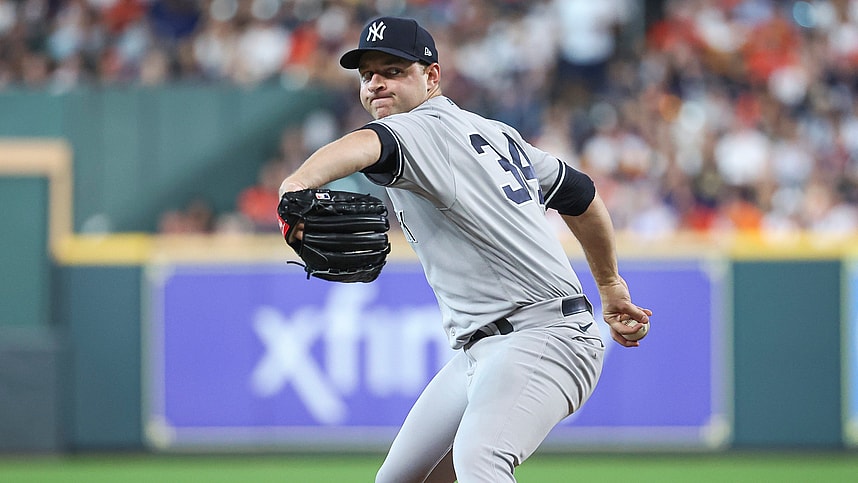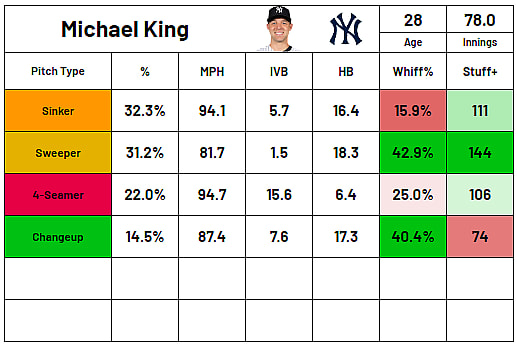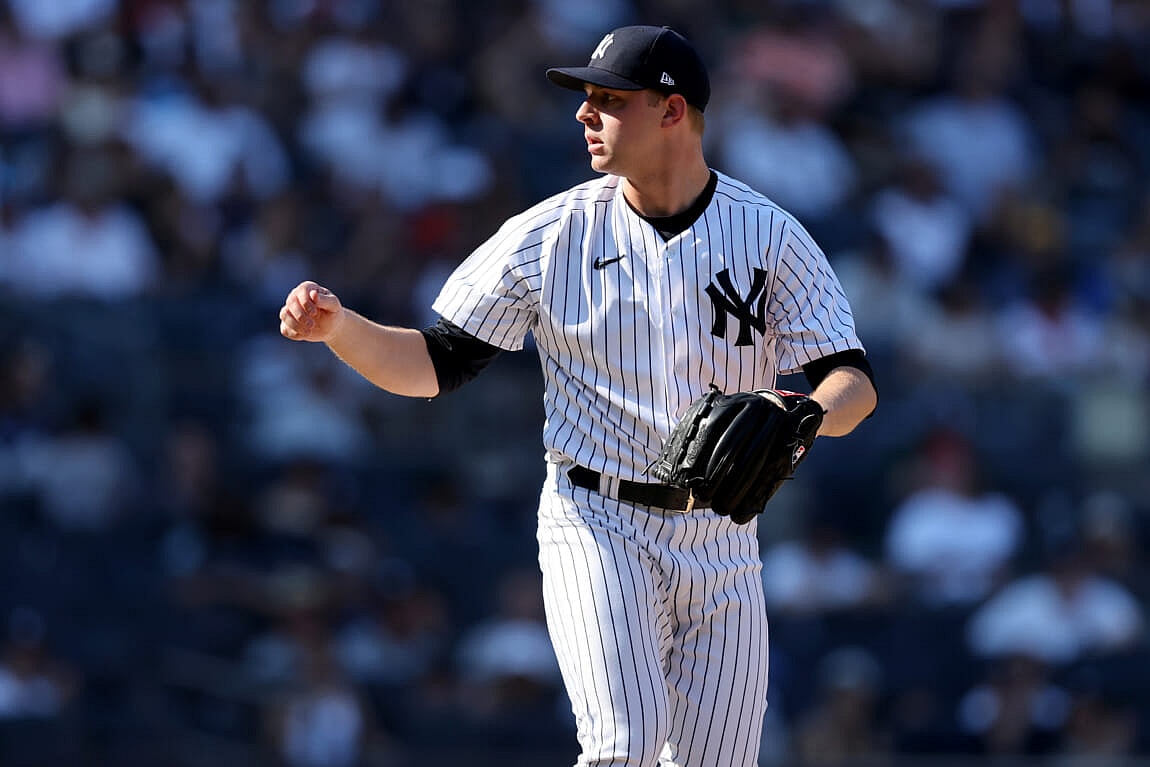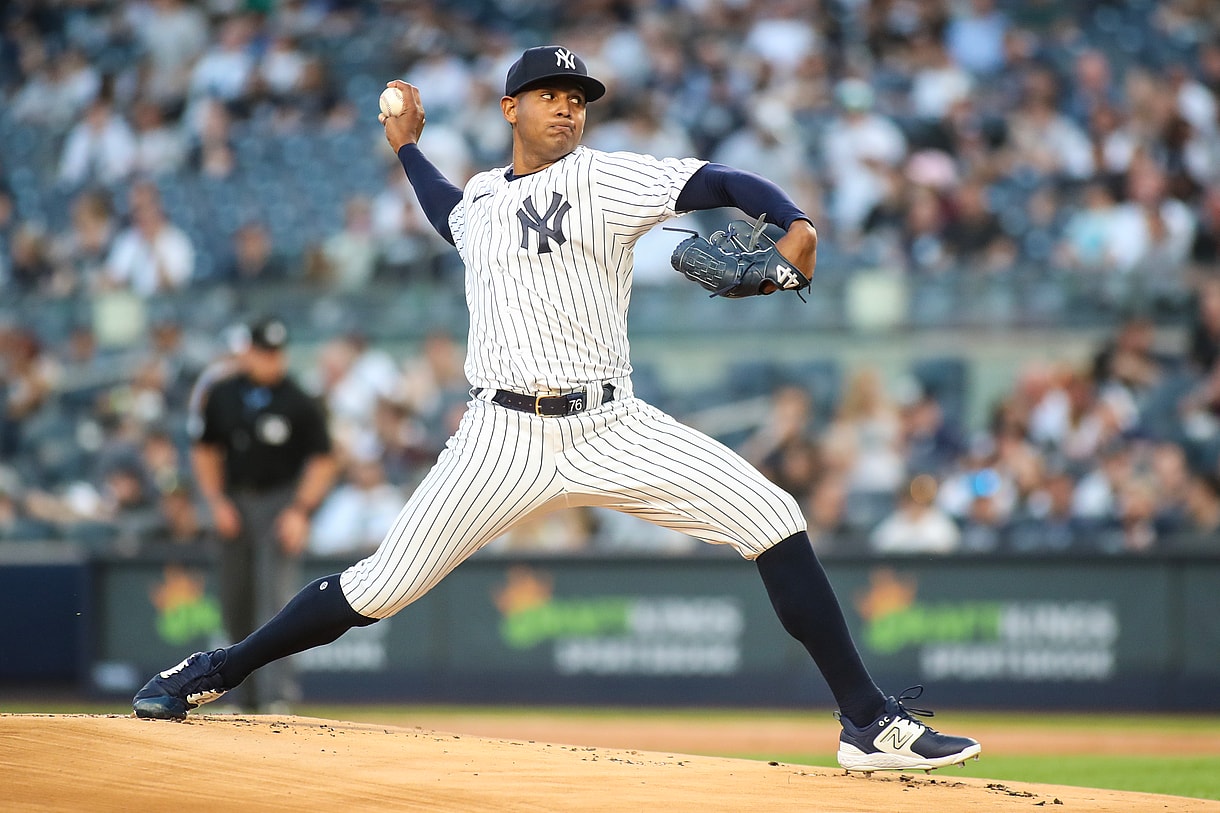
One of the Yankees‘ biggest issues all season has been their growing list of injuries. Starters like Nestor Cortes, Frankie Montas, Carlos Rodon, and Luis Severino have been ravaged by injuries and underperformance. In what seemed like a desperate attempt to find another starting pitcher, the Yankees began stretching out Michael King for a starting role to end the season, and while presenting itself as no more than an experiment to try to piece together starts as their season began to fall apart, it’s evolved into something greater.
Following a brilliant start against the Astros, one of baseball’s top teams, Michael King is opening a lot of eyes on the pitching side, which could result in him becoming a reliable starting option.
How Does Michael King’s Stuff Play as a Starter?
Typically, you need a pitch mix that plays to lefties and righties, and while Michael King has had all of his success as a reliever, people forget that he didn’t possess the same pitch mix last time he attempted to be a starter. King throws fewer pitches now than he did then, which, on the surface, seems counterintuitive for someone trying to transition into a starter. In the case of Michael King, it serves to simplify his pitch mix into four plus-pitches that give him all of the weapons he needs to handle both lefties and righties.
Looking at his last two starts where he completed four and five innings respectively, he’s used his sinker the most (42.3%) and it serves to set up the rest of his arsenal. His sinker plays predominately against right-handed hitters, and he has a 111 Stuff+ on the offering due to over 17″ of horizontal run that can jam hitters and induce soft contact alongside groundballs. Horizontal movement plays best to right-handed hitters, and his sinker sets up an incredible sweeping slider that King has employed since the summer of 2021.
One of the biggest differences between Michael King’s first go-around as a starter and this second attempt is that great sweeping breaking ball. In terms of Run-Value, his sweeper has actually been a net negative for King (-4), although he still gets plenty of whiffs on it and induces soft contact. Batters have a .262 average but a .219 expected average, and it still has a wicked 1454 Stuff+, making it one of the best sweepers in the game and a pitch that puzzles right-handed hitters.
He’s been able to improve upon his velocity on the sweeper in these two outings, as while he’s sat at 81.7 MPH on the season, in these past two starts where he’s been stretched out a lot more, he’s sitting 82.8 MPH with 16.6″ of horizontal sweep. These two pitches alone would be good enough for a pitcher to excel in a bullpen role, but as a starter, you’ll need to establish vertical deception as well to handle opposite-handed batters who have success against pitches that lean on horizontal movement over vertical deception.
The first weapon King has for left-handed hitters is his four-seam fastball, which has a 106 Stuff+ on the season and has ramped up to 95.6 MPH, and while his velocity can fluctuate on his fastball offerings, as long as he hovers between 94-95 MPH, his four-seamer is going to play up in the strike zone. On the surface, 15.8″ of Induced Vertical Break shouldn’t result in a strong Stuff+, but it’s the low slot release coupled with strong velocity allows it to play up in the strike zone, setting up a nasty changeup.
Michael King’s changeup doesn’t perform well in Stuff+ (74), but most changeups don’t. Eno Sarris himself has talked about the importance arm speed plays in a changeup and how the lack of public biomechanical data limits our ability to understand changeups, but King’s has always produced strong results. It’s his best pitch according to Run-Value (+7) and has a .136 wOBA and 40.4% Whiff% against, and it’s a weapon he relies upon heavily to deal with left-handed batters.

It’s rare that you find a pitcher with three great pitches, but in the case of Michael King, you could reasonably argue he has four. From a stuff basis, King undoubtedly has what it takes to be an effective starter, and it’s why he’s been so successful in the role early on. He hasn’t taken the hit to his velocity that we anticipated he would, and while the sample size is still pretty small, the underlying data and pitch shapes are highly encouraging.
Against the Astros, he went heavily with his sinker against a lineup that had plenty of right-handed batters, and it displays his versatility as a pitcher. Depending on the lineup, King establishes different planes of deception, whether vertically or horizontally, and it’s why he’s been one of the Yankees’ most consistent arms in terms of strikeout-to-walk rate. The results speak for themselves, as since the Yankees decided to stretch Michael King out, he’s been remarkable:
- 2.89 ERA
- 3.31 FIP
- 27.0% K%
- 6.8% BB%
- 1.13 WHIP
He’s given up his fair share of barrels, but if he continues to put up excellent strikeout rates and prevent walks, he’ll likely still serve as a viable arm. The question becomes, can Michael King really pitch deep into games?
The Yankees’ Blueprint For Building Up Michael King
The biggest question most have regarding Michael King and his viability as a starter has to stem from innings pitched, both in-game and in-season. First and foremost, the Boston College product has set a career-high in innings at the Major League level this year (78), exceeding his 2021 total (51) and the most innings he’s tossed since 2018 (161) when he ascended from High-A to Triple-A. King is more than capable of getting to the 100-inning threshold, but the Yankees have been careful with King following the elbow fracture he suffered in 2022.
If King makes more starts this month, it’s possible he gets close to 100 innings pitched, and that could allow him to push closer to 140 innings in 2024. We’ve seen the Yankees do this before, as they transitioned Nestor Cortes from a reliever into a starter in 2021 to try to piece together starts down the stretch. It worked beautifully for the 2021 team, who then parlayed the 108 innings he tossed in Triple-A and with the Major League team into an All-Star year in 2022. So far, we haven’t seen the dropoff in Stuff+ that you typically see with a reliever transitioning into a starter.
The Yankees were careful with Cortes in 2021, and they’ll have to exercise that same caution with Michael King, but the early returns mirror the early returns we got on Cortes when he first began transitioning into a starter. He first worked as an opener, where he tossed 3.1 innings against the Mets and 4.2 innings against the Astros before COVID halted his development for two weeks. Cortes would come out of the bullpen against Boston before completing five innings for the first time in the season against the Tampa Bay Rays, and he’s been a starter for the Yankees ever since.
Cortes was quicker to ramp up due to the fact that he wasn’t coming off of an elbow fracture the year prior, but breaking into the five-inning threshold is an important step in a starter’s development. King faced 18 batters, meaning he completed two times through the order successfully, doing so against the defending World Series Champions as well.

We’ve established that on a Stuff+ basis, there aren’t concerns about Michael King’s ability to navigate a lineup, it’s just a matter of finding the durability to do so. The Yankees don’t want another elbow injury for their workhorse out of the bullpen, but at the same time, the upside of him becoming a starter is pretty evident. The strikeouts, great stuff, and improved command combine for a profile that should result in an above-average Major League starter, but the issue stems from the fact that it adds another question mark to their rotation.
Nestor Cortes and Carlos Rodon both spent meaningful time on the IL and likely need to be monitored in terms of their workload, and while Clarke Schmidt and Gerrit Cole will have workloads they can carry into 2024 seamlessly, that gives them three starters who you aren’t sure will make their start every fifth day. For the Yankees’ future aspirations, does it really make much sense to take another risk in their rotation?
- The Yankees might have found their next Luke Weaver in $2 million signing
- Yankees predicted to land Bo Bichette but the reason is ludicrous
- Yankees re-sign Paul Blackburn to one-year $2 million contract
Fitting Michael King into the Yankees’ 2024 Plans
As of right now, the Yankees have four of their five projected starters for 2024 and are seeking a fifth starter, but they could again take a look at recent memory to fill out that final rotation spot. Just as Nestor Cortes assimilated into a starting role in 2022 and took off, we could see Michael King mirror Cortes’ progression and see him win a job in the rotation out of Spring Training. You can’t expect an All-Star appearance, but there’s a formula for this to work remarkably well for the Yankees.
First and foremost, the Yankees have two arms from their farm system who will look to compete for the final rotation spot in Jhony Brito and Randy Vasquez, but if both were to lose out to King, they could serve as reliable multi-inning arms out of the bullpen that could follow Michael King. Jhony Brito, in particular, really stands out because of how remarkable he’s been as a reliever, delivering 21.1 innings with a 1.27 ERA and 48.2% GB%. He’s done it with a brand-new sweeper that helps him get right-handed batters out while still possessing a high-90s sinker and strong changeup.
He’s struggled mightily as a starter, but perhaps a bullpen role suits him best, although he most certainly has time to iron out his issues in the first inning. Brito gives the Yankees much-needed insurance to eat up innings following King, and they could piece those days together to get between six to eight innings reliably from the duo. Furthermore, the Yankees have Drew Thorpe in Double-A, currently mowing down his competition, striking out nearly 34% of batters faced on the season while posting a 2.53 ERA and reliably pitching deep into games.

Furthermore, the Yankees can use the money they would have spent on a starting pitcher to find another bat to supplement their roster since they’re in need of some talent to surround the rookies on the diamond. Sure, the Yankees are taking a risk with that fifth starter spot, but the depth of their pitching staff can certainly provide enough for the team to stomach the growing pains King will go through when it comes to handling a new workload. Their farm system is robust, with arms such as Clayton Beeter, Will Warren, Chase Hampton, and Richard Fitts also looking to find roles in the 2024 pitching staff.
Relying on high-upside arms with great stuff to figure it out and produce has been the Yankees’ philosophy in their pitching staff for a while, but they haven’t had the internal talent they boast today. They’ve done it before with Nestor Cortes, and with the influx of starting pitching they have internally, they have ways to supplement their rotation if Michael King is hurt, needs to have his innings limited, or isn’t transitioning well into a starter’s role. It’s certainly not traditional, but this is a sport that’s constantly evolving.
The only way to find out if Michael King is a starter or not is by giving him the chance, and while this year gives the Yankees a window to experiment with the idea, it could become a viable option in 2024 as well.
More about: New York Yankees